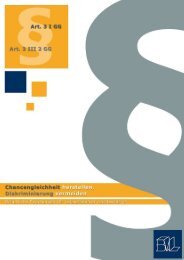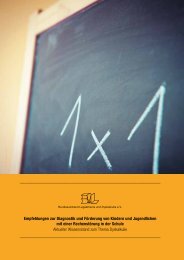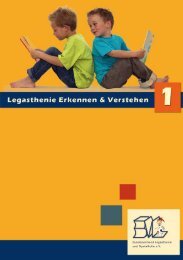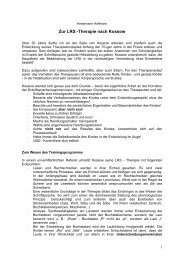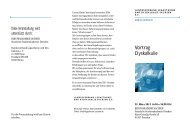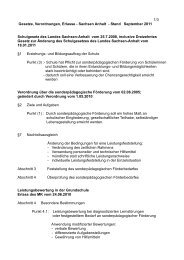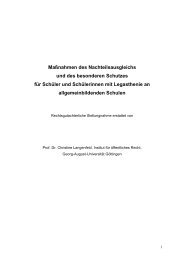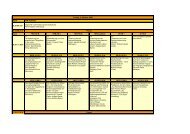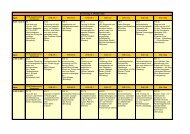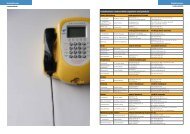Testverfah - Bundesverband Legasthenie und Dyskalkulie eV
Testverfah - Bundesverband Legasthenie und Dyskalkulie eV
Testverfah - Bundesverband Legasthenie und Dyskalkulie eV
Sie wollen auch ein ePaper? Erhöhen Sie die Reichweite Ihrer Titel.
YUMPU macht aus Druck-PDFs automatisch weboptimierte ePaper, die Google liebt.
Abstractband 15. Kongress des <strong>B<strong>und</strong>esverband</strong>es <strong>Legasthenie</strong><br />
Richter, B. (2003). Deutsches Handbuch zum Programm AUDILEX. http://www.<br />
paedboutique.de/frameset_audilex.htm, 26.04.2005.<br />
Korrespondenzautor:<br />
Jörg Reichert<br />
joerg.reichert@rz.hu-berlin.de<br />
++49 030 20934427<br />
++49 030 20934435<br />
Sensory processing in dyslexia<br />
*Hanna Renvall<br />
Helsinki University of Technology, Brain Research Unit, Low Temperature Laboratory, Helsinki,<br />
Finnland<br />
Dyslexic individuals encounter difficulties that often extend beyond the skills directly<br />
needed for reading: for example, language-learning-impaired children are slow<br />
in processing so<strong>und</strong>s presented in rapid succession or containing fast frequency<br />
transitions. These auditory deficits, at a time scale of up to a few h<strong>und</strong>reds of milliseconds,<br />
persist to adult age. Recent behavioral studies have implied that dyslexic<br />
subjects have temporal processing deficits in other sensory modalities as well.<br />
We have applied magnetoencephalography (MEG) and psychophysics to characterize<br />
the temporal impairments in auditory, tactile and visual domains in dyslexic<br />
adults. Our results demonstrate that dyslexic adults are deficient in processing<br />
so<strong>und</strong>s and acoustic changes presented in rapid succession within tens to h<strong>und</strong>reds<br />
of milliseconds. In line with the proposed pansensory processing deficit, responses<br />
to rapidly presented tactile stimuli were diminished in the right somatosensory cortex<br />
of dyslexic subjects, and abrupt visual stimuli captured attention in both visual hemifields<br />
less effectively in dyslexic than normal-reading adults. Furthermore, dyslexics<br />
showed right visual field advantage, suggestive of a left-sided “minineglect”. On the<br />
basis of these and earlier findings we have proposed that limitations in both modality-specific<br />
and more global attentional capacities could prolong input chunks for all<br />
senses, thereby leading to anomalous cortical representations in dyslexic subjects<br />
[1]. MEG provides a powerful tool for characterizing sensory processing deficits, but<br />
further studies are needed to clarify the relationship between sensory-specific cortical<br />
processing and phonological processing deficits in dyslexia.<br />
[1] Hari, R., Renvall, H. 2001. Impaired processing of rapid stimulus sequences in<br />
dyslexia. TICS 5, 525-532.<br />
Korrespondenzautor:<br />
Hanna Renvall<br />
hanna@neuro.hut.fi<br />
80



